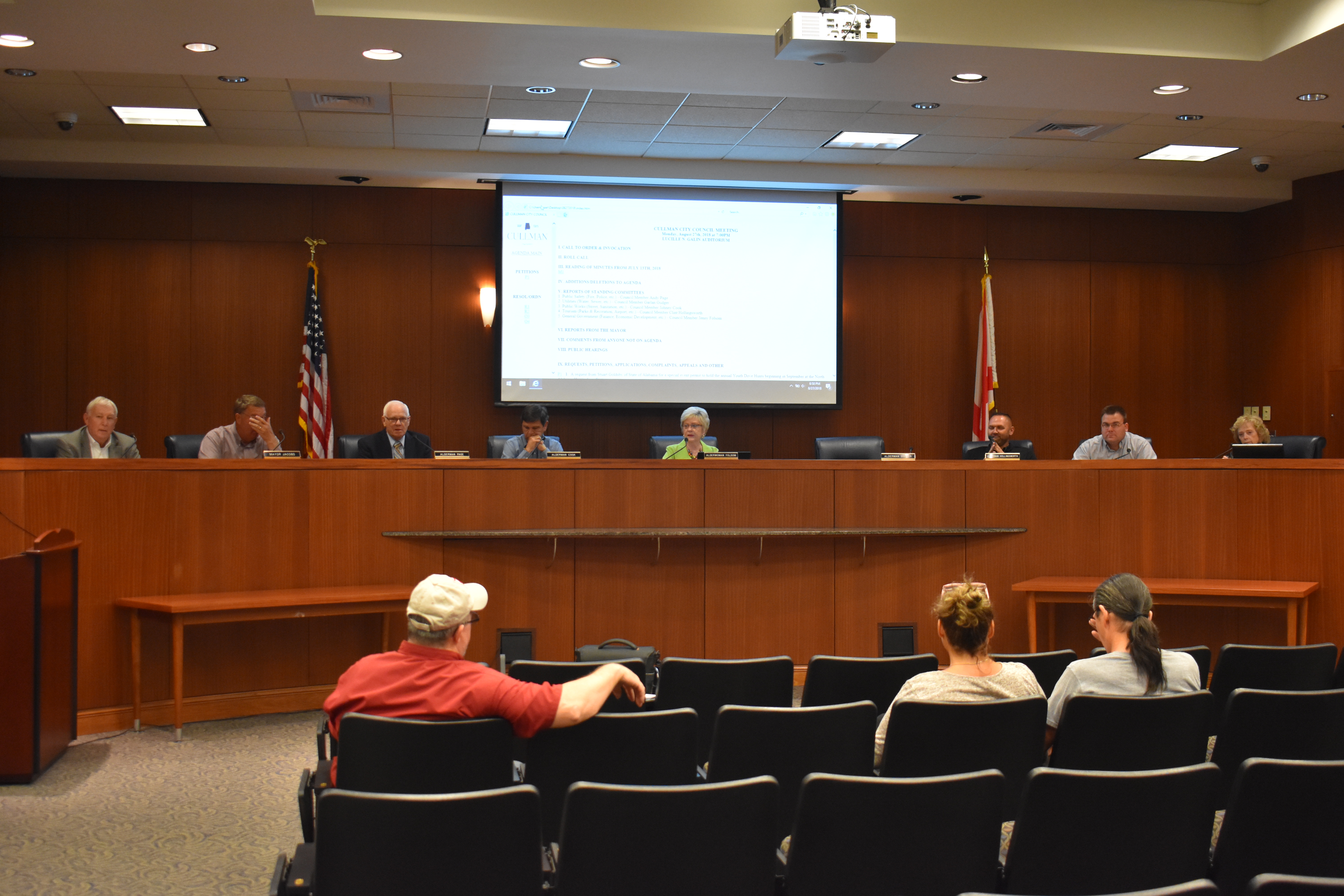Three residents of the Heritage Village subdivision wait to address the Cullman City Council Monday night. (W.C. for The Cullman Tribune)
CULLMAN – On Monday evening, the Cullman City Council had a brief agenda, but saw its meeting protracted by residents of the Heritage Village subdivision. Resident Kerry Zozoka and others, who have been addressing city council and planning commission meetings since May, had vowed to continue making their voices heard until street paving and stormwater drainage issues in the neighborhood were resolved.
City inspectors visited Heritage Village over the summer, focusing on a swale–a shallow drainage ditch–running down the center of the one fully developed internal block in the development. According to site plans, residents’ property lines meet in the middle of the block, but the city has a 20-foot-wide easement down the middle of the block, with the swale in the center of that. Inspectors found fences and other structures constructed in the easement in violation of city codes. After that discovery, residents had to begin taking structures down, but not all have complied.
During his report time, Mayor Woody Jacobs explained to the council and audience that the City has had an independent engineering firm assess the situation in Heritage Village and had City Attorney Roy Williams read a letter from the firm, stating its findings. Before that, Williams stated that the firm, St. John & Associates, had reviewed the original plats and drainage plan, and had formulated the following opinion (taken from an audio recording of Williams reading the letter):
“It appears that the contractor who built the individual houses on Joy St. and Irene Ln. at Heritage Village graded the lots to incorporate a central drainage swale at the back of all the houses on the block. This is different from the sheet drain concept that was initially planned, but not necessarily a worse way of dealing with stormwater.
“It looks like the present grading plan works well, with the possible exception of high flows after rain events at the lowest lots on the block. It is usually the builder’s responsibility to ensure that the storm drainage is managed on each lot as it is developed. I’m not aware of any requirement for the city to review individual house site grading plans.
“We did observe that many of the houses have created obstructions in the flow path that may be affecting the swale. These obstructions include fences, patios, step-offs, steps off the back of the houses. The lot lines are quite close, and swale makes up most of the backyard of these lots.
The sanitary sewer line runs beneath the lot line in question and would likely prohibit the installation of any storm sewer lines. The owners could possibly create a paved swale to transmit the flow faster, but this would require a good bit of demolition of the above-noted improvements that are in the flow path.”
Williams handed out copies for the Heritage Village residents who were present. Zozoka took to the podium next, noting that city workers had come out and cut through the curb at the end of the swale, which is at the back corner of her property. She stated that she had been told by city workers that they were going to install a drain. Jacobs explained that he had stopped work on that spot while waiting on the engineer’s report.
Zozoka accused the mayor and street department of targeting Heritage Village residents with their survey and subsequent report that construction in the easement violated city codes. Jacobs countered that the subdivision has not been subjected to inspections or regulations that are not common around the city.
In the face of an increasingly heated confrontation, Council President Jenny Folsom asked Williams to speak again.
Williams told Zozoka, “If you look at that letter (that had just been distributed), you’ll clearly see that the engineers say it’s your problem. It’s not the City’s problem. It’s your problem: it’s the way your house was built, it’s the way your neighbor’s house was built, the way their neighbor’s house was built. And you put the water in the back of your yard.
“The only way to fix it, okay, is to dig up the sewer line, which the developer put in there, too. We didn’t put the sewer line in. That was the developer that put it in.”
Zozoka countered, “I’m telling you: you guys have messed up this neighborhood and the drainage system, and if you lived here, it would be a different story. I have never been ugly, I have never been ugly. All I’m asking you guys to do is fix it. And when you guys don’t fix it, it leads me to realize there’s a bigger issue that you guys are hiding. And that’s all I have to say. It’s on you guys, and I’m not going away until it’s fixed.”
Other council business
The council approved:
- a request from Stuart Goldsby of the State of Alabama for a special event permit to hold the annual Youth Dove Hunts beginning in September at the North Alabama Horticulture Station.
- a resolution to award the bid for Airport Taxiway Reconstruction Phase II to the lowest responsible bidder, Carcel & G Construction, LLC, in an amount not to exceed $412,867.17. Most of the funding will come from federal and state sources. The City and County will only be responsible for 2.5 percent of the amount each. Airport Manager Ben Harrison, who attended the meeting, also informed the council about a potential supplemental grant to make improvements to the airport’s apron (also known as the tarmac, where aircraft are parked, fueled, loaded and unloaded) that will help Cullman’s airport compete better with other regional airports. Harrison will travel to Washington on Sept. 10 to apply for the federal funding which would, if given, be a 100 percent grant requiring no local match.
- a resolution to enter into an agreement with the Alabama Department of Transportation for the installation, operation and maintenance of sidewalk improvements, landscape and decorative pedestrian lighting, installed at AL-74 (US-278) at First Avenue Southeast to Third Avenue Southeast.
- an ordinance to vacate and surplus a 100-foot easement (approximately 100 feet by 370 feet) and a portion of the 25-foot easement (approximately 25 feet by 1,075 feet) located on Lot 1 of Industrial Park V (near Yutaka) to the Industrial Development Board. The ordinance received a favorable recommendation from the City of Cullman Planning Commission.
The council gave a first reading to a new wastewater/sewer ordinance, without specifying details. It also voted to reappoint Jason Neal to the CAT 55 Board and to reappoint Nathan Allred to the Downtown Development Board.
The Cullman City Council meets on the second and fourth Mondays of each month at 7 p.m. in the Cullman City Hall auditorium. The public is invited to attend.
Copyright 2018 Humble Roots, LLC. All Rights Reserved.





















